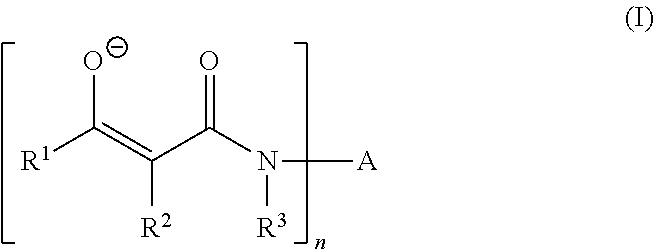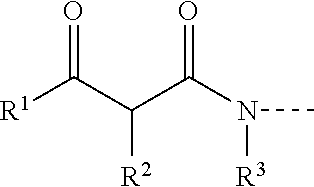Metal complex compounds as catalysts for polyurethane compositions
a technology of metal complex compounds and catalysts, applied in the direction of group 3/13 element organic compounds, group 5/15 element organic compounds, etc., can solve the problems of less adhesion, poor shape stability, and lower mechanical strength
- Summary
- Abstract
- Description
- Claims
- Application Information
AI Technical Summary
Benefits of technology
Problems solved by technology
Method used
Image
Examples
example 1
Catalyst Mo1
[0113]According to general preparation procedure C, 3.24 g of dioxomolybdenum (VI) bis(acetylacetonate) and 5.67 g of 1,3-ketoamide 1 were reacted. One obtained 7.86 g of a reddish, glasslike solid.
[0114]FT-IR: 2969, 2930, 2873, 1717, 1588, 1496, 1371, 1333, 1266, 1195, 1104, 1028, 991, 931, 903, 776, 734.
example 2
Catalyst Mo2
[0115]According to general preparation procedure C, 3.70 g of dioxomolybdenum (VI) bis(acetylacetonate) and 5.60 g of 1,3-ketoamide 4 were reacted. One obtained 7.42 g of a brownish, glasslike solid.
[0116]FT-IR: 3305, 2972, 2930, 2873, 1715, 1588, 1514, 1446, 1401, 1361, 1267, 1182, 1104, 1028, 969, 932, 898, 795, 733, 701, 668.
example 3
Catalyst Mo3
[0117]According to general preparation procedure C, 1.80 g of dioxomolybdenum (VI) bis(acetylacetonate) and 3.66 g of 1,3-ketoamide 5 were reacted. One obtained 4.46 g of a brownish oil.
[0118]FT-IR: 2968, 2869, 1720, 1626, 1564, 1517, 1446, 1401, 1369, 1266, 1182, 1092, 1007, 968, 931, 896, 794, 668.
PUM
| Property | Measurement | Unit |
|---|---|---|
| temperature | aaaaa | aaaaa |
| temperature | aaaaa | aaaaa |
| temperature | aaaaa | aaaaa |
Abstract
Description
Claims
Application Information
 Login to View More
Login to View More - R&D
- Intellectual Property
- Life Sciences
- Materials
- Tech Scout
- Unparalleled Data Quality
- Higher Quality Content
- 60% Fewer Hallucinations
Browse by: Latest US Patents, China's latest patents, Technical Efficacy Thesaurus, Application Domain, Technology Topic, Popular Technical Reports.
© 2025 PatSnap. All rights reserved.Legal|Privacy policy|Modern Slavery Act Transparency Statement|Sitemap|About US| Contact US: help@patsnap.com



